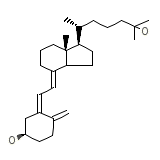Calcifidiol




Calcifidiol Brand names, Calcifidiol Analogs
Calcifidiol Brand Names Mixture
- No information avaliable
Calcifidiol Chemical_Formula
C27H44O2
Calcifidiol RX_link
No information avaliable
Calcifidiol fda sheet
Calcifidiol msds (material safety sheet)
Calcifidiol Synthesis Reference
Blunt, DeLuca, ibid. 8, 671.
Calcifidiol Molecular Weight
400.637 g/mol
Calcifidiol Melting Point
No information avaliable
Calcifidiol H2O Solubility
Insoluble
Calcifidiol State
Solid
Calcifidiol LogP
5.785
Calcifidiol Dosage Forms
Capsules
Calcifidiol Indication
Used to treat vitamin D deficiency or insufficiency, refractory rickets (vitamin D resistant rickets), familial hypophosphatemia and hypoparathyroidism, and in the management of hypocalcemia and renal osteodystrophy in patients with chronic renal failure undergoing dialysis. Also used in conjunction with calcium in the management and prevention of primary or corticosteroid-induced osteoporosis.
Calcifidiol Pharmacology
Calcidiol is a form of vitamin D3. Vitamin D3 is a steroid hormone that has long been known for its important role in regulating body levels of calcium and phosphorus, in mineralization of bone, and for the assimilation of Vitamin A. The classical manifestations of vitamin D deficiency is rickets, which is seen in children and results in bony deformaties including bowed long bones. Deficiency in adults leads to the disease osteomalacia. Both rickets and osteomalacia reflect impaired mineralization of newly synthesized bone matrix, and usually result from a combination of inadequate exposure to sunlight and decreased dietary intake of vitamin D. Common causes of vitamin D deficiency include genetic defects in the vitamin D receptor, severe liver or kidney disease, and insufficient exposure to sunlight. Vitamin D plays an important role in maintaining calcium balance and in the regulation of parathyroid hormone (PTH). It promotes renal reabsorption of calcium, increases intestinal absorption of calcium and phosphorus, and increases calcium and phosphorus mobilization from bone to plasma.
Calcifidiol Absorption
Readily absorbed.
Calcifidiol side effects and Toxicity
Bone pain, constipation (especially in children or adolescents), diarrhea, drowsiness, dryness of mouth; headache (continuing), increased thirst, increase in frequency of urination, especially at night, or in amount of urine, irregular heartbeat, itching skin, loss of appetite, metallic taste, muscle pain, nausea or vomiting (especially in children or adolescents), unusual tiredness or weakness.
Calcifidiol Patient Information
Patient information for vitamin D analogues (Vitamin D2, Vitamin D3, Calcitriol, and Calcidiol):
The patient and his or her parents or s.o.s. should be informed about compliance with dosage instructions, adherence to instructions about diet and calcium supplementation and avoidance of the use of unapproved nonprescription drugs. Patients should also be carefully informed about the symptoms of hypercalcemia.
The effectiveness of vitamin D therapy is predicated on the assumption that each patient is receiving an adequate daily intake of calcium. Patients are advised to have a dietary intake of calcium at a minimum of 600 mg daily. The U.S. RDA for calcium in adults is 800 mg to 1200 mg.
The patient and his or her parents or s.o.s. should be informed about compliance with dosage instructions, adherence to instructions about diet and calcium supplementation and avoidance of the use of unapproved nonprescription drugs. Patients should also be carefully informed about the symptoms of hypercalcemia.
The effectiveness of vitamin D therapy is predicated on the assumption that each patient is receiving an adequate daily intake of calcium. Patients are advised to have a dietary intake of calcium at a minimum of 600 mg daily. The U.S. RDA for calcium in adults is 800 mg to 1200 mg.
Calcifidiol Organisms Affected
Humans and other mammals














